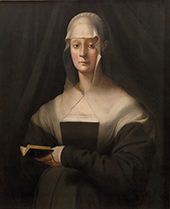Jacopo Pontormo Oil Painting Reproductions
Jacopo Pontormo replica paintings on Canvas for sale
Jacopo Pontormo Florentine Mannerist Painter
Jacopo Pontormo was born Jacopo Carruci in 1494 at Empoli, Florence. He later moved to Florence, where he remained for most of his life.
As one of the most prominent Mannerism artists, Pontormo's paintings are renowned for their vivid colors. The emotional intensity of his work sets him apart as a significant painter of Religious art.
Influences from Leonardo da Vinci and Michelangelo.
Famous Renaissance artists, including Leonardo da Vinci and Michelangelo, influenced Pontormo's religious paintings and impacted his work.
Leonardo da Vinci’s use of soft light and shadow, known as chiaroscuro, heavily influenced Pontormo’s biblical paintings. This technique provides a sense of depth and realism to his work. Pontormo's dramatic compositions display Michelangelo's influence.
The Mannerist Style during the Renaissance Art period.
As artists like Pontormo sought to explore new forms of expression. Mannerism paintings emerged as a reaction to the harmony of High Renaissance art. This style allowed artists to break traditional norms and depict complex stories with heightened emotions.
The Key Characteristics of Mannerism Paintings
- Elongated Figures: Mannerism artists often depict figures with elongated torsos and limbs creating a sense of grace and elegance.
- Exaggerated Poses: High stylized and unnatural poses in Mannerism art add a dynamic quality to compositions.
- Mannerism art features bright and vivid colors that enhance the emotional impact of the paintings.
Florentine Paintings by Jacopo Pontormo
- Deposition from the Cross was painted between 1525 and 1528 for the Capponi Chapel in the Santa Felicita Church in Florence.
Pontormo's painting shows how he expressed strong feelings through his art in a Mannerist style. Pontormo's famous painting depicts the moment when they take Christ's body down from the Cross. Unlike other paintings, Pontormo's version of Christ being taken from the cross arranges the figures in a complex and almost chaotic manner.
The faces of the figures convey various emotions, from sorrow and grief to resignation and contemplation.
Deposition from the Cross exemplifies the artist’s ability to capture human experience movingly and profoundly. It depicts an emotionally charged scene, and his paintings significantly impacted the development of religious art during the Italian Renaissance art movement. - The artist painted The Visitation, also known as the Carmignano Visitation, between 1528 and 1530 for the church of San Michele in Carmignano.
It depicts the meeting between the Virgin Mary and Saint Elizabeth, and Pontormo’s use of vibrant colors and elongated mannerist figures highlight an emotional connection between the two women.
- Joseph in Egypt. In 1982, the National Gallery in London purchased this painting and five others to celebrate Pierfrancesco Borgherini and Margherita Accaiouli's marriage.
- Leda and the Swan, painted circa 1512, is a mythological painting at the Uffizi Gallery in Florence. Jacopo da Pontormo’s painting refers to the Greek myth of Zeus falling in love with Leda, the Queen of Sparta.
The legacy of Jacopo Pontormo’s paintings.
Pontormo’s influence extended beyond his lifetime, paving the way for later mannerism artists such as Agnolo Bronzino.
Jacopo Pontormo's paintings influenced many artists who followed him. His emphasis on emotion and movement balanced paintings of the High Renaissance. His contribution to the Mannerism art movement has cemented his place as one of the most influential artists of the Renaissance period.
Discover our exciting collection of fine art reproductions of Mannerism paintings by other famous artists, including El Greco and Bronzino.
Cannot Find What You Are Looking For?
Reproduction Gallery Information
Customer Service
(Send Us A Message)
Tel: (503) 937 2010
Fax: (503) 937 2011







































